
Introduction to scientific experiments.
A free CK-12 account is required to view all materials.
- Subject:
- Mathematics
- Science
- Material Type:
- Lesson
- Provider:
- CK-12 Foundation
- Provider Set:
- CK-12 Biology
- Date Added:
- 11/15/2023

Introduction to scientific experiments.
A free CK-12 account is required to view all materials.

Covers the scientific experimental design.
A free CK-12 account is required to view all materials.
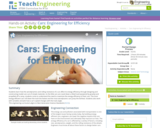
Students learn how the aerodynamics and rolling resistance of a car affect its energy efficiency through designing and constructing model cars out of simple materials. As the little cars are raced down a tilted track (powered by gravity) and propelled off a ramp, students come to understand the need to maximize the energy efficiency of their cars. The most energy-efficient cars roll down the track the fastest and the most aerodynamic cars jump the farthest. Students also work with variables and plot how a car's speed changes with the track angle.

Overview of how to write algebraic expressions with step-by-step examples.

Improve a writing assignment by creating an automated editing program with code. Time to complete: 4-6 hours

The CyberSquad uses algebra to figure out how many gleamers they need and how many power glows are produced by each gleamer as they must power up a Cyberspace ship in this video from Cyberchase. [1:43]
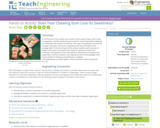
In the first part of the activity, each student chews a piece of gum until it loses its sweetness, and then leaves the gum to dry for several days before weighing it to determine the amount of mass lost. This mass corresponds to the amount of sugar in the gum, and can be compared to the amount stated on the package label. In the second part of the activity, students work in groups to design and conduct new experiments based on questions of their own choosing. These questions arise naturally from observations during the first experiment, and from students' own experiences with and knowledge of the many varieties of chewing and bubble gums available.

Using the LEGO® NXT robotics kit, students construct and program robots to illustrate and explore the Fibonacci sequence. Within teams, students are assigned roles: group leader, chassis builder, arm builder, chief programmer, and Fibonacci verifier. By designing a robot that moves based on the Fibonacci sequence of numbers, they can better visualize how quickly the numbers in the sequence grow. To program the robot to move according to these numbers, students break down the sequence into simple algebraic equations so that the computer can understand the Fibonacci sequence.

Can you break the magic number code? Test your algebra aptitude in this challenge that explores number generalizations, symbols, and equations. Discover how algebraic procedures are used in everyday situations in this one page activity from the NCTM Math Challenges for Families series.

In this video segment from Cyberchase, Harry has a fixed budget for clothing, so he must figure out what combination of jackets and pants he can buy with $100.

Students examine random variables and distributions. Topics explored are probability distributions, and discrete and continuous random variables. The tutorial investigates the statistics concepts through class notes and examples. Review exercises and a chapter quiz are included.
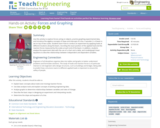
Use this activity to explore forces acting on objects, practice graphing experimental data, and introduce the algebra concepts of slope and intercept of a line. A wooden 2 x 4 beam is set on top of two scales. Students learn how to conduct an experiment by applying loads at different locations along the beam, recording the exact position of the applied load and the reaction forces measured by the scales at each end of the beam. In addition, students analyze the experiment data with the use of a chart and a table, and model/graph linear equations to describe relationships between independent and dependent variables.

The CyberSquad tries to figure out how Hackerë_í__ cyberfrog moves when its various buttons are pressed, in this video from Cyberchase.

In this video from Cyberchase, the CyberSquad must figure out the new input/output pattern on Hackerë_í__ larger cyberfrog.
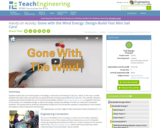
Students explore the use of wind power in the design, construction and testing of "sail cars," which, in this case, are little wheeled carts with masts and sails that are powered by the moving air generated from a box fan. The scientific method is reviewed and reinforced with the use of controls and variables, and the engineering design process is explored. The focus of the activity is on renewable energy, as well as the design, testing and redesign of small cars made from household materials. The activity (and an extension worksheet) includes the use of kinematic equations using distance, time traveled and speed to enforce exponents and decimals.
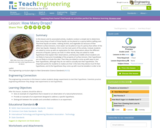
In this lesson and its associated activity, students conduct a simple test to determine how many drops of each of three liquids can be placed on a penny before spilling over. The three liquids are water, rubbing alcohol, and vegetable oil; because of their different surface tensions, more water can be piled on top of a penny than either of the other two liquids. However, this is not the main point of the activity. Instead, students are asked to come up with an explanation for their observations about the different amounts of liquids a penny can hold. In other words, they are asked to make hypotheses that explain their observations, and because middle school students are not likely to have prior knowledge of the property of surface tension, their hypotheses are not likely to include this idea. Then they are asked to come up with ways to test their hypotheses, although they do not need to actually test their hypotheses. The important points for students to realize are that 1) the tests they devise must fit their hypotheses, and 2) the hypotheses they come up with must be testable in order to be useful.
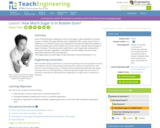
Most of the flavoring in gum is due to the sugar or other sweetener it contains. As gum is chewed, the sugar dissolves and is swallowed. After a piece of gum loses its flavor, it can be left to dry at room temperature and then the difference between its initial (unchewed) mass and its chewed mass can be used to calculate the percentage of sugar in the gum. This demonstration experiment is used to generate new questions about gums and their ingredients, and students can then design and execute new experiments based on their own questions.

This site defines and discusses the ideal gas law. The concept of state variables is explained and the various state variables are identified. Links to further information is available.

Using this tutorial, you'll learn how to solve a formula for a variable and how to solve word problems involving formulas.

Visualize solutions to one variable equations by performing a balancing act. This interactive exercise focuses on linear equations and mathematical reasoning to show how one variable equations need to stay balanced to be solved correctly then you get to model your own problems and solve.